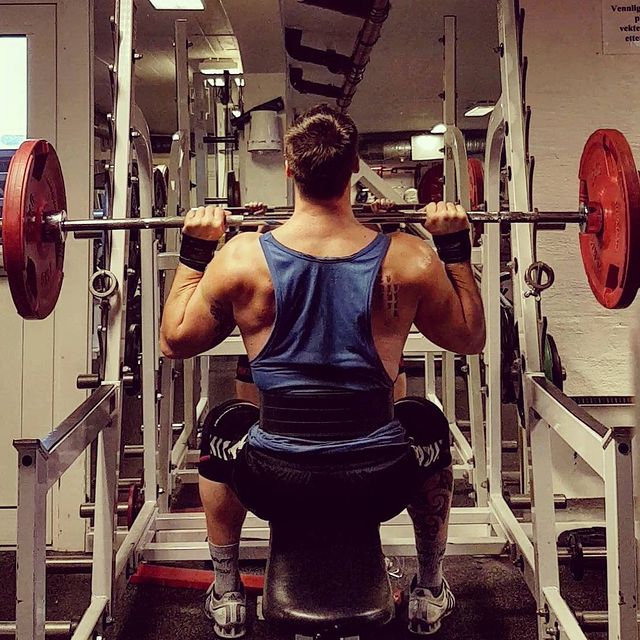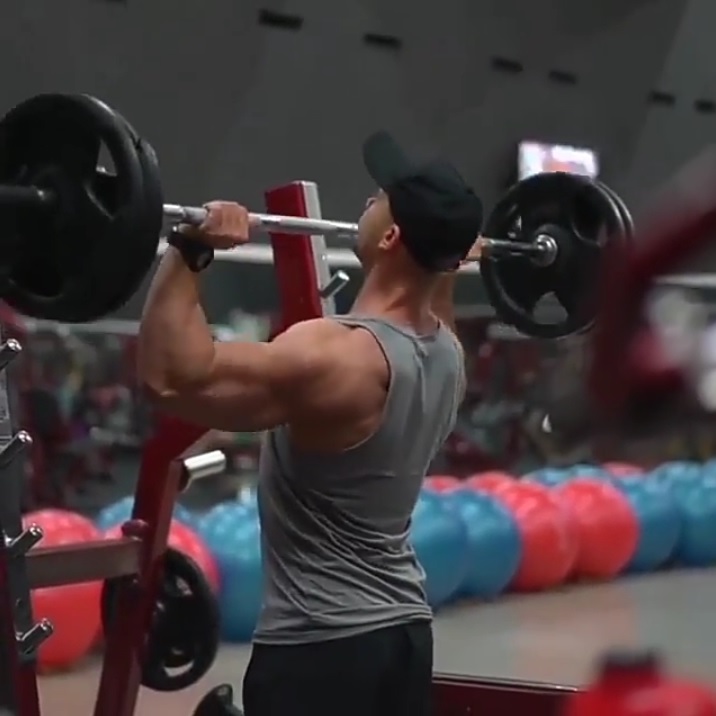The military press is one of the best all-around shoulder exercises you can do. It is a simple, easy to learn activity that allows heavy weights to be lifted safely.
What is the military press or overhead press?

Military press, also known as shoulder press or overhead press or strict press, is a complete shoulder building exercise for building shoulder muscles. The military press can be trained as a power lift or in traditional muscle-building rep ranges as part of full-body, shoulder-focused, or upper-body training.
There are two forms of military press:
- Seated military press or Seated overhead press
- Standing military press or Standing overhead press
Performing both standing and seated overhead presses is a great way to develop strength and hypertrophy in multiple muscle groups in the shoulders and upper body.1
The standing press requires tremendous core and lower back strength to maintain balance, which in turn limits the amount of weight you can lift. But the standing shoulder press is better for functional strength and for people who do weightlifting, powerlifting, strongman, or CrossFit.
Seated presses are better for hypertrophy because they separate the shoulders more.2 It’s also a better option for people who haven’t built up much core strength yet.
While there’s nothing inherently wrong with this, you may find that doing heavy deadlifting and squatting every week builds more than enough core and lower back strength; so I like to use this lift to maximize the overload on the shoulders.
Thus, I go with the seated press or seated overhead press and recommend that you do the same.3
How to do military/overhead press properly?
Want Bigger, Stronger Shoulders? Nail this step, and you’ll be on your way.
Now let’s talk, first starting with the seated military press, then with seated overhead press.
1. Seated Military Press

If your gym doesn’t have this piece of equipment or if you can’t do something similar using a power rack and utility bench, you can opt for a standing variation, which you can do in a squat rack.
Setup and movement
- Place feet on the floor shoulder-width apart, toes and knees slightly out.
- Press heels into the ground to keep upper back and butt in place on the back of the bench.
- Grip the bar as you would during a bench press: the bar at shoulder width and above your wrists, not in your fingers.
- The back should be in a neutral position.
- To begin the descent, take a deep breath, tighten the abs and glutes, and push the chest up.
- Lower the bar straight down toward your clavicles, and keep your elbows in the same position as you would during a bench press; Don’t force them to stay by your side, and don’t let them slide too far behind you.
- Tilt your head back and look forward, not straight up, to allow the bar to pass through your nose and chin.
- This is why a full bench doesn’t work for military presses: You can’t tilt the head back to get it out of the way, and you’re forced to lower the weight below the chest, which is wrong.
- There should be a slight arch in the lower back at the bottom of the lift, but don’t overdo it, as this can lead to injury when you start loading more and more weight. If you’re bending too far, the weight is probably too heavy.
- Once it reaches the clavicle, lift it straight up through the descent, and once it passes the forehead, lean the torso forward slightly and squeeze the glutes.
- Continue raising the bar until elbows are locked. Shoulders, traps and back should be tight and squeezed.
- Slowly lower the bar, take another deep breath, and repeat.
First, generally the best option is to use a rack and bench chair to set the barbell at the proper height. When choosing a height to set J-hooks, the barbell should sit in the upper chest area. Remember, you need to be able to unlock the bar. When placing the seat, you want the chest to be roughly in line with the rack. Position it so that you only have to lean forward slightly.
The second choice is using a typical seated barbell press bench; Some gyms have this type of bench. However, you will quickly find these to cause issues, as no one bench can possibly fit everyone. Either the seat is too low or set too far back; Something almost always goes wrong. Regardless, you just have to deal with it.
The other option is using the Smith machine seated press, which is an effective alternative to the free weight seated barbell overhead press. However, it is not an all-round pressing exercise because the fixed barbell eliminates the need for stability, which is an important aspect of building overhead pressing strength. This makes the Smith Machine more of a hypertrophy-based isolation exercise.
2. Standing Military Press

Setup and movement
The standing press is done exactly the same way – you just stand. The bar rests on the squat rack at the same height as you were doing the squat, and once you’ve unhooked it.
- Adjust the barbell to just below shoulder height, then load the desired weight onto the bar.
- Assume a shoulder-width stance and place your hands on the bar with a pronated grip (or just outside) shoulder-width apart.
- Step under the bar and unroll it, keeping the spine in a neutral position.
- Take two steps back, inhale, brace, tuck chin, then press bar to overhead lockout.
- Reach tall at the top and don’t worry about keeping shoulders down and back.
- Let the elbows rotate and point out at the top of the movement, but keep them tight from the rib-cage at the bottom.
- Fight to control the bar by rotating your wrists into extension, and think of “rolling your knuckles up toward the ceiling.”
- Keep the pace out of range, and don’t add any additional leg drive by bending and extending the knees.
- Squeeze your glutes and brace your abs as you press up. You shouldn’t lean too far back when pressing.
- Once the bar is locked out, exhale and slowly reverse the motion while controlling the bar back to your chest.
- Repeat for desired number of repetitions.
3. Tips
Full-range of motion
- Many lifters lower the weight until their arms reach a 90-degree angle, barely past the head.
- But this only engages about 1/2 the muscles that can be targeted with this exercise.
- You should at least get the bar down to your chin, and if your shoulders are injury free (bless you), you should be able to bring it up to your chest.
- If you’re guilty of this mistake, don’t be ashamed. Just gear up and start doing it the right way. You’ll have to drop some weight from your normal sets, but it’s worth it to get the full range of motion.
Stick out your elbows under the bar
- To keep your elbows from flaring, keep your elbows under the bar throughout the lift.
- At the bottom of each rep, your elbows should be slightly in front of the bar. Not exactly like front squats, but they don’t have to be in line with your shoulders.
- This quick, minor fix will also prevent shoulder pain and wrist pain. Don’t forget to follow similar form for your bench press as well.
Watch the bar go up instead of forward
- Resist the urge to watch the bar go up! It is not easy, but it is necessary.
- If you do this, position yourself in front of a mirror. That way, you can still see yourself and monitor your form without straining your neck back.
Bottom line
The military press is one of the best mass builders for delts, as a compound movement it helps increase muscle size and strength, develops the core, and improves posture.
The press is a strict overhead press, it requires keeping the heels together and using only the arms and shoulders to lift the weight.
Many ways to press the military. You can do this movement from a seated or standing position with a barbell, dumbbells, kettlebells or resistance bands.
Seated military presses are gentler on the spine and ensure better support than standing military presses. So it is suitable for a person with back pain.
Avoid this exercise if you have a rotator cuff injury, herniated disc, round back posture, or other back or shoulder problems. Alternate between the overhead press and other shoulder exercises to keep the muscles guessing and reduce the risk of injury.
However, this press is in no way inferior to a bench press or a traditional overhead press. Quite the contrary – it provides a full body workout and has incredible carryover to other exercises. This is one of the best movements for the anterior and lateral delts, but it also targets the posterior delts.
Due to its rigid form, this exercise makes it difficult to injure the shoulders. However, you do need to focus on lifting form, and that’s what I discuss today.
- Saeterbakken AH, Fimland MS. Effects of body position and loading modality on muscle activity and strength in shoulder presses. J Strength Cond Res. 2013 Jul;27(7):1824-31. doi: 10.1519/JSC.0b013e318276b873. PMID: 23096062.[↩]
- Kroell, Jordan BS, CSCS, USAW; Mike, Jonathan PhD, CSCSD, NSCA-CPTD, USAW. “Exploring the Standing Barbell Overhead Press,” Strength and Conditioning Journal 39(6):p 70-75, December 2017. DOI: 10.1519/SSC.0000000000000324.[↩]
- Source: Bigger Leaner Stronger: The Simple Science of Building the Ultimate Male Body. By Michael Matthews. Available here: https://amzn.to/3S7dyYD[↩]














